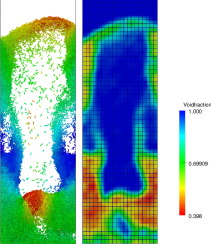当前位置:
X-MOL 学术
›
Chem. Eng. Sci.
›
论文详情
Our official English website, www.x-mol.net, welcomes your feedback! (Note: you will need to create a separate account there.)
Non-spherical particles in a pseudo-2D fluidised bed: Modelling study
Chemical Engineering Science ( IF 4.7 ) Pub Date : 2018-12-01 , DOI: 10.1016/j.ces.2018.08.041 Vinay V. Mahajan , Tim M.J. Nijssen , J.A.M. Kuipers , Johan T. Padding
Chemical Engineering Science ( IF 4.7 ) Pub Date : 2018-12-01 , DOI: 10.1016/j.ces.2018.08.041 Vinay V. Mahajan , Tim M.J. Nijssen , J.A.M. Kuipers , Johan T. Padding

|
Abstract Fluidised beds are used in a variety of processes because of their favourable mass and heat transfer characteristics. In this and many other processes, non-spherical particles are commonplace, which can drastically affect the fluidisation behaviour. In this study, we use numerical models to study non-spherical fluidisation behaviour in detail. A crucial step in the development of the numerical model is a detailed validation with experimental data. The validated model can then be used with confidence for further investigations. In this study, the results obtained from CFD-DEM modelling are compared with detailed experiments (Mahajan et al., 2017). The particles used are of spherocylindrical shape with an aspect ratio 4. We discuss the numerical modelling strategy including the DEM contact detection algorithm and accurate voidage calculation algorithm. The non-spherical single particle drag model of Holzer and Sommerfeld (2008) is compared with a DNS drag model for spherocylindrical particles developed in-house. We propose two new voidage correction models and compare results with the (Di Felice, 1994) model. The pressure drop, bed height, particle orientation, particle circulation, stacking of particles and coordination number obtained from simulations are compared with experiments. The numerical measurements show good agreement with experiments. Similar to experiments, simulations show that rod-like particles are prone to interlocking behaviour. At high gas flow rates above the minimum fluidisation velocity, vigorously bubbling fluidisation is observed, with gas bubbles moving up through the center and particles moving down at the side walls. The orientation of particles in the fluidised state do not match with the experiments when hydrodynamic torque is neglected. The importance of hydrodynamic torque and multi-particle drag in CFD-DEM modelling of non-spherical particles is demonstrated through these results.
中文翻译:

伪二维流化床中的非球形颗粒:建模研究
摘要 流化床因其良好的传质和传热特性而被用于各种工艺。在这个过程和许多其他过程中,非球形颗粒很常见,这会极大地影响流化行为。在这项研究中,我们使用数值模型来详细研究非球形流化行为。开发数值模型的一个关键步骤是对实验数据进行详细验证。然后可以放心地使用经过验证的模型进行进一步的调查。在本研究中,将从 CFD-DEM 建模获得的结果与详细实验进行比较(Mahajan 等,2017)。所使用的颗粒为长径比为 4 的球形。我们讨论了数值建模策略,包括 DEM 接触检测算法和精确空隙率计算算法。将 Holzer 和 Sommerfeld (2008) 的非球形单颗粒阻力模型与内部开发的用于球形圆柱颗粒的 DNS 阻力模型进行了比较。我们提出了两种新的空隙率校正模型,并将结果与 (Di Felice, 1994) 模型进行比较。将模拟得到的压降、床层高度、颗粒取向、颗粒循环、颗粒堆积和配位数与实验进行了比较。数值测量与实验显示出良好的一致性。与实验类似,模拟表明棒状粒子易于产生互锁行为。在高于最小流化速度的高气体流速下,观察到剧烈鼓泡流化,气泡通过中心向上移动,颗粒在侧壁向下移动。当忽略流体动力扭矩时,流化状态下颗粒的取向与实验不匹配。这些结果证明了流体动力扭矩和多颗粒阻力在非球形颗粒的 CFD-DEM 建模中的重要性。
更新日期:2018-12-01
中文翻译:

伪二维流化床中的非球形颗粒:建模研究
摘要 流化床因其良好的传质和传热特性而被用于各种工艺。在这个过程和许多其他过程中,非球形颗粒很常见,这会极大地影响流化行为。在这项研究中,我们使用数值模型来详细研究非球形流化行为。开发数值模型的一个关键步骤是对实验数据进行详细验证。然后可以放心地使用经过验证的模型进行进一步的调查。在本研究中,将从 CFD-DEM 建模获得的结果与详细实验进行比较(Mahajan 等,2017)。所使用的颗粒为长径比为 4 的球形。我们讨论了数值建模策略,包括 DEM 接触检测算法和精确空隙率计算算法。将 Holzer 和 Sommerfeld (2008) 的非球形单颗粒阻力模型与内部开发的用于球形圆柱颗粒的 DNS 阻力模型进行了比较。我们提出了两种新的空隙率校正模型,并将结果与 (Di Felice, 1994) 模型进行比较。将模拟得到的压降、床层高度、颗粒取向、颗粒循环、颗粒堆积和配位数与实验进行了比较。数值测量与实验显示出良好的一致性。与实验类似,模拟表明棒状粒子易于产生互锁行为。在高于最小流化速度的高气体流速下,观察到剧烈鼓泡流化,气泡通过中心向上移动,颗粒在侧壁向下移动。当忽略流体动力扭矩时,流化状态下颗粒的取向与实验不匹配。这些结果证明了流体动力扭矩和多颗粒阻力在非球形颗粒的 CFD-DEM 建模中的重要性。



























 京公网安备 11010802027423号
京公网安备 11010802027423号